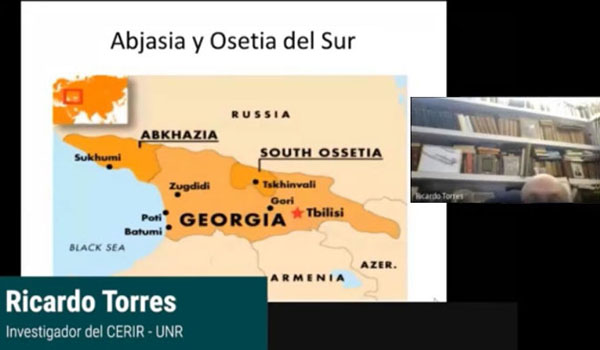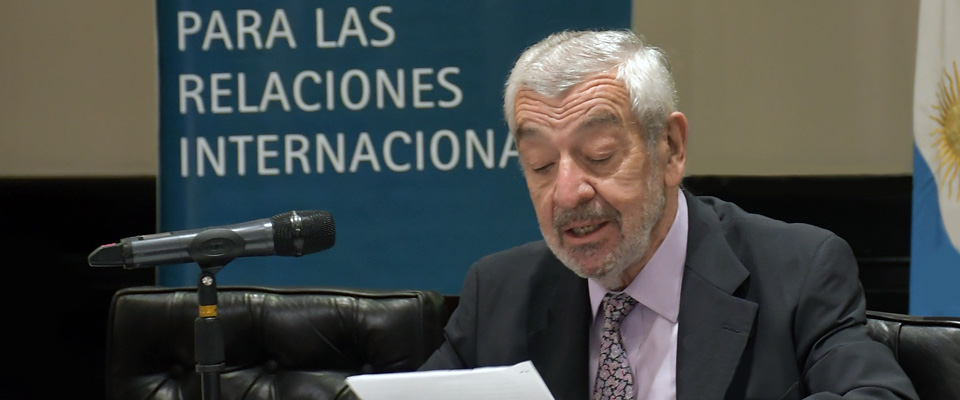
August 20, 2020
Academic session conducted by Ricardo Torres
By Jerónimo C. Besaglia, Volunteer for the Communications Division
The academic session "The Conflicts of Abkhazia and South Ossetia", organized by CARI's Working Group on Contemporary Studies of the Eurasian Space, had Ricardo Torres, Doctor of International Relations by the National University of Rosario (UNR) and researcher at CERIR-UNR, as the main presenter. His areas of research are the Caucasus, nationalism, and secessionism. Torres hosted the event virtually on August 20, 2020.
Ricardo Torres proceeded to detail the general characteristics of Abkhazia and South Ossetia and placed them on the map. He then discussed the development considering limited international recognition, history, wars in the early 1990s, the 2008 war, and finally today's conclusions and analysis.
In both Abkhazia and South Ossetia, "institutional quality is quite low", said Ricardo Torres, with partial international recognition from Russia, Venezuela, Nicaragua, Nauru, paid of course by Russia, Syria, etc..., and they recognize each other.
Ricardo Torres noted that Abkhazia has "a rather interesting and independent history of Georgia" and that "it is important to remember that at the beginning of its independence (in 1922) the Abkhaz sought to have status as a separate republic within the USSR".
On the other hand, South-State Ossetia of Alania began as a popular front in 1988. It sought to have its status of Autonomous Oblast elevated to the Autonomous Republic. It was ultimately declared an Autonomous Soviet Socialist Republic, which was again annulled by Georgia.
Moving on to the wars of 1991-1994, Georgia occupied Abkhazia in 1992, and then lost it to Abkhaz supported by the countries of the North Caucasus. This culminated into a ceasefire, negotiated in Sochi in 1993, and led to a massacre and migration flows of Georgians from Abkhazia, with an end to the ceasefire negotiated in Moscow in 1994.
Georgia declared a state of emergency given the economic blockade imposed by South Ossetia, followed by the occupation by Georgian and Russian troops. A meeting of Yeltsin and Gamsakhurdia in 1991 followed to restore peace and in March 1991 there was a temporary ceasefire. South Ossetia proclaimed independence in December 1991 and Georgia's retaliation destroyed 80% of the city of Tsjinvali culminating in the Sochi ceasefire in 1992 and a peacekeeping force. Again there is a demographic shift of 22000 Georgians.
In 2004 President-elect Saakashvili closed the Ergeneti market, a trading space between Georgians and Ossetians, and conflicts remain constant (2004, 2006, 2007).
Turning to the 2008 war, "peace was always quite unstable between Abkhazia, South Ossetia and Georgia." Clashes between South Ossetia and Georgia continued even after the March 7 ceasefire. Tsjinvali occupation by Georgia on August 8th is "considered the triggering event of the war, even though there were clear provocations by the Ossetians and Russian presence", and then they are expelled by Russian troops. Sarkozy negotiated the ceasefire on August 12th and the Russians withdrew. Meanwhile Abkhazia opened a second front and occupied Kodori.
Finally, Ricardo Torres's conclusion is the depth of the integration of Abkhazia and South Ossetia, not just economically, but also on the political side: they will "probably join the Russian Federation, especially South Ossetia, which can integrate with its sister republic North Ossetia, which is on the other side of the border, although Russia at the moment has not shown much trouble. Russia enters the candidates and the ones that make it in the elections are the ones it imposes", Torres adds. It has the counterface of the zero possibility of Georgia's reacquisition of the territories.
Lila Roldán Vázquez, Coordinator of the Working Group on Contemporary Studies of the Eurasian Space, highlighted the complexity of the situation throughout the area and the incredible number of peoples and ethnicities in the region, as well as the Russian presence and control of the Black Sea.
Ricardo Torres closed the exhibition showing the ethno-linguistic map of the Caucasus, coinciding with the enormous regional complexity providing different demographic data.


























